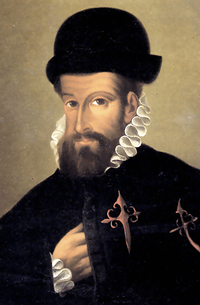Francisco Pizarro Politician
Francisco Pizarro González (/pɪˈzɑroʊ/; Spanish: [piˈθaro]; c. 1471 or 1476 – 26 June 1541) was a Spanish conquistador who conquered the Incan Empire.Pizarro González was born in Trujillo, Spain, the illegitimate son of Gonzalo Pizarro, an infantry colonel, and Francisca González, a woman of poor means. His exact birth date is uncertain, but is believed to be sometime in the 1470s, probably 1471. Scant attention was paid to his education and he grew up illiterate. He was a distant cousin of Hernán Cortés. On 10 November 1509, Pizarro sailed from Spain to the New World with Alonzo de Ojeda on an expedition to Urabí. He sailed to Cartagena and joined the fleet of Martín Fernández de Enciso, and, in 1513, accompanied Balboa to the Pacific. In 1514, he found a supporter in Pedrarias Dávila, the Governor of Castilla de Oro, and was rewarded for his role in the arrest of Balboa with the positions of mayor and magistrate in Panama City, serving from 1519 to 1523.Reports of Peru's riches and Cortés's success in Mexico tantalized Pizarro and he undertook two expeditions to conquer the Incan Empire in 1524 and in 1526. Both failed as a result of native hostilities, bad weather, and lack of provisions. Pedro de los Ríos, the Governor of Panama, made an effort to recall Pizarro, but the conquistador resisted and remained in the south. In April 1528, he reached northern Peru and found the natives rich with precious metals. This discovery gave Pizarro the motivation to plan a third expedition to conquer Peru, and he returned to Panama to make arrangements, but the Governor refused to grant permission for the project. Pizarro returned to Spain to appeal directly to King Charles I. His plea was successful, and he received not only a license for the proposed expedition but considerable authority over any lands conquered during the venture. He was joined by family and friends, and the expedition left Panama in 1530.When hostile natives along the coast threatened the expedition, Pizarro moved inland and founded the first Spanish settlement in Peru, San Miguel de Piura. Inca Atahualpa refused to tolerate a Spanish presence in his lands but was captured by Pizarro during the Battle of Cajamarca on 16 November 1532. A ransom for the Emperor's release was demanded and Atahualpa filled a room with gold, but Pizarro charged him with various crimes and executed Atahualpa on 26 July 1533, much to the opposition of his associates who thought the conquistador was overstepping his authority. The same year, Pizarro entered the Incan capital of Cuzco, and the conquest of Peru was complete. In January 1535, Pizarro founded the city of Lima, a project he considered his greatest achievement. Quarrels between Pizarro and his longtime comrade-in-arms Diego Almagro culminated in the Battle of Las Salinas. Almagro was captured and executed, and, on 26 June 1541, his embittered son assassinated Pizarro in Lima. The conqueror of Peru was laid to rest in the Lima Cathedral.When historians compare Pizarro's and Cortés's conquests of Peru and Mexico, they usually give the palm to Pizarro because he led fewer men, faced larger armies, and was far from Spanish outposts in the Caribbean which could have supplied men, arms, and provisions. After Pizarro's death, his family built a palace commemorating the conquistador on the Plaza Mayor in Trujillo, but modern Peruvians look askance at Pizarro, considering him the force behind the destruction of their indigenous culture, language, and religion.
Search
Politician
| military operations | |
|---|---|
| monarch | |
| service start | 1496 |
| service end | 1541 |
| successor |
Topical connections
Francisco Pizarro on Wikipedia
External resources
- http://bloknot.info/juan-de-samanos-relacion-de-los-primeros-descubrimientos-peru-francisco-pizarro-y-diego-de-almagro-1526
- http://books.google.com/books?hl=en&id=fD0HAAAAQAAJ&dq=Pizarro+by+Sheridan&printsec=frontcover&source=web&ots=aqypa7CUHG&sig=N6roRUJbMbVqmBysGvcQM_RxcC0&sa=X&oi=book_result&resnum=1&ct=result#PPP5,M1
- http://hdl.loc.gov/loc.rbc/kislak.74661.1
- http://kuprienko.info/cartas-del-marques-don-francisco-pizarro-1533-1541
- http://kuprienko.info/cedula-de-encomienda-de-francisco-pizarro-a-diego-maldonado-cuzco-15-de-abril-de-1539
- http://www.pbs.org/conquistadors/pizarro/pizarro_flat.html
- http://www.ucalgary.ca/applied_history/tutor/eurvoya/inca.html
- http://www.ucpress.edu/books/pages/9547/9547.excerptlong.html#first
